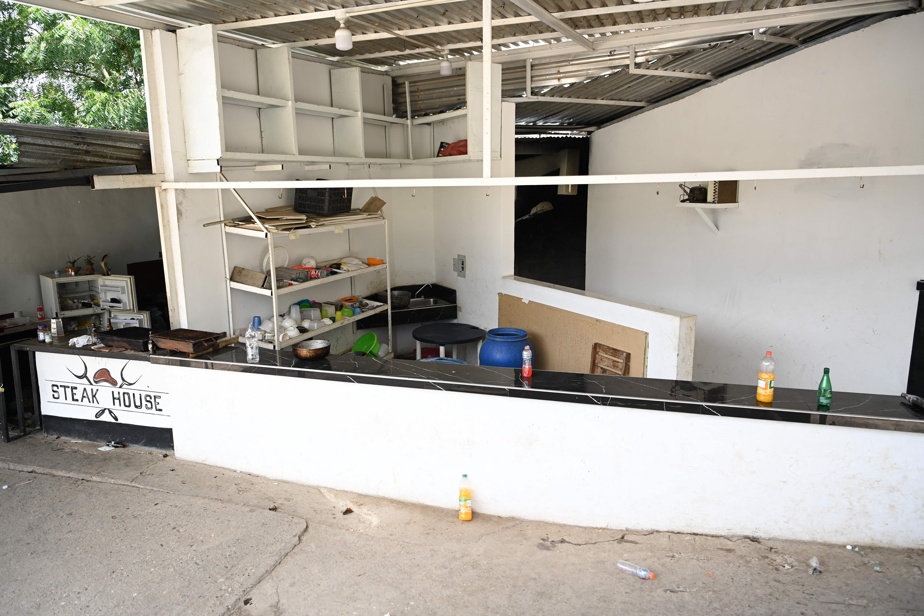(Caracas) « Steak house. Enjoy », We can read on the walls of one of the restaurants and bars of the Tocoron prison, in north-central Venezuela, where the sprawling criminal gang Tren de Aragua had made its headquarters.
The “steak house” is located next to the swimming pool, a double circular pool spanned by a small bridge with columns… Further on, a playground with slides. “Life was more pleasant and safer in the prison than outside,” the wife of a former inmate, now transferred, told AFP on condition of anonymity.
As part of an operation to dismantle the Tren de Aragua gang, 11,000 members of the security forces invaded the prison on Wednesday, now emptied of most of its inmates. On Saturday, the authorities organized a guided tour, very supervised and very partial, of the site, “now completely under control”.
The thirty or so invited journalists will not see the concrete tunnels dug by the gang whose images are circulating on the networks or the zoo with its pink flamingos. Even less the cells.
On a wooden door, we can read “Bolivarian National Guard: the Tren de Aragua, it’s over”. A message for journalists, but undoubtedly intended to be relayed across the country.
The Tren de Aragua, which reportedly numbers some 5,000 criminals, appeared in 2014, operating in “classic” mafia activities: kidnappings, robberies, drugs, prostitution, extortion. It has extended its influence to other activities, some legal, but also illegal mining. It is present in eight Latin American countries, including Colombia, Peru and Chile.
Racketeering the prison population was one of the gang’s main activities.
During the visit, bulldozers destroy a small “neighborhood” of brick, wood and sheet metal houses. The authorities do not give an explanation, while the machines crush walls, bedding, curtains, buckets…
At the morgue
Met on Wednesday, Rubeles Mejias, 25, in a relationship for 7 years with an inmate, sentenced to 13 years in prison for homicide, lived 7 months in the prison.
She only left her when her 4-year-old daughter had to go to school. Her “man” with whom she was to marry in 15 days, is one of the “Baptized”. In the prison, these Christians who dressed in white were a separate caste that the “malandros” (bandits) did not bother.
“It was quiet, there was a swimming pool, a zoo. My husband worked in a small prison store,” explained this young hairdresser. “He’s the one who helps me” financially.
The few streets traveled in the prison are now transformed into a cemetery of beer bottles, piles of clothes, remains of household appliances (television, CD player), stuffed animals… On a wall, a drawing of the cartoon “The Tasmanian Tiger”.
On the street near the swimming pool and the basketball court, stalls with empty displays follow one another. On Wednesday, AFP journalists observed that police were evacuating air conditioners, televisions and other motorcycles.
Three of the last few inmates of the prison, dressed in yellow outfits, sweep the surroundings of the penitentiary.
The prison, designed for 750 people, officially had 1,600 inmates, some 2,500 according to independent estimates. Authorities announced 88 arrests of gang members.
The leader of the “El nino Guerrero” gang has disappeared, and benefited from complicity and even negotiated with the government, according to the NGO Venezuelan Prison Observer.
In the street, the crowd of relatives wanting news of detainees has decreased compared to the day before and the day before, but for those who are there, it is still worrying.
Claribel Rojas cries. She has no news from her brother. Nesbelis Mavares is looking for her partner who committed femicide. “The last message I had was a voice note from Wednesday where he said ‘I love you. God bless you” “.
“They are inmates but not animals. A guard told us ‘look at the morgue or a dead person in the hills’,” she said.
